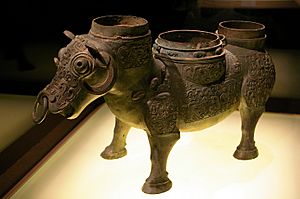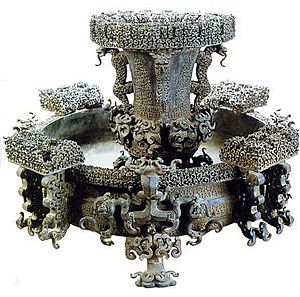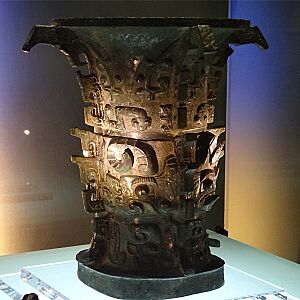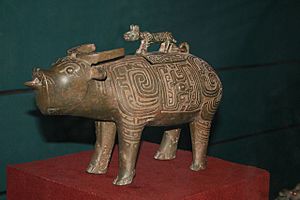Zun facts for kids
Quick facts for kids Zun |
|||||||||||||||||
|---|---|---|---|---|---|---|---|---|---|---|---|---|---|---|---|---|---|
| Chinese | 尊 | ||||||||||||||||
|
|||||||||||||||||
| Alternative Chinese name | |||||||||||||||||
| Chinese | 彝 | ||||||||||||||||
|
|||||||||||||||||
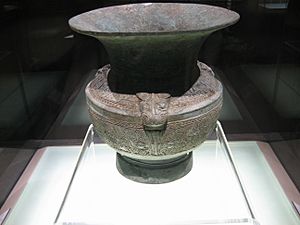
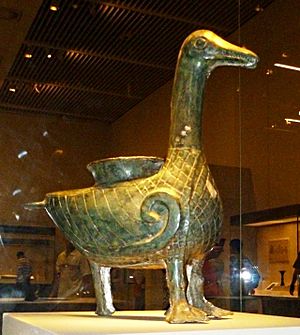
The zun or yi is a special type of Chinese bronze or ceramic container. People in ancient China used them to hold wine during important religious ceremonies. These vessels first appeared during the Shang dynasty.
Zuns usually look like a vase, either round or square. Sometimes, they were even shaped like animals! They have a wide opening at the top, which made it easy to pour wine. You can find zuns shaped like dragons, oxen, geese, and many other creatures. One famous example is the He zun from the Western Zhou period.
Contents
What was the Zun used for?
The zun was a ritual container, meaning it was used for special ceremonies in ancient China. Its main job was to hold wine offered to people who had passed away. It's a tall cup without handles or legs. The top opening is usually wider than the rest of the body.
Some zun vessels, like the Xi zun, could even keep the wine warm! This was very clever for its time. It's one of the few bronze pieces found that could do both: store wine and heat it up.
What do Zun decorations mean?
Zuns come in many shapes, from simple vase-like forms to detailed animal figures. They often have special designs carved into them, which have deep meanings.
One very common design is the taotie. This is a mysterious face, sometimes called a "demon-face" or "sacrificial animal face." It was a popular design on Chinese ritual bronzes during the Shang dynasty. The taotie often looks like two animal bodies joined together, with big, staring eyes that stick out from the bronze. These eyes might have represented the eyes of a powerful animal.
These animal designs were also important because people believed they helped shamans (spiritual leaders) connect with the heavens and talk to the dead.
Zun made from different materials
While many zuns are made of bronze, some were also made from ceramic. They came in various forms, from simple designs to very detailed ones. Some were square, some were cylindrical, and others were shaped like animals.
Animals that inspired zun shapes include elephants, oxen, sheep, horses, rhinoceroses, and birds. The basic cylindrical shape was often used, but with many creative changes. Some zuns were tall and thin, while others were short and round.
The decorations on zuns also varied a lot. Some had designs that stood out, giving them a textured feel. Others were smooth, highlighting the vessel's sleek shape. Taller zuns sometimes had decorative ridges, called flanges, running from the top to the bottom.
Famous Zun examples
Four-goat Square Zun
- Period: Shang Dynasty
- Height: 58.3 cm
- Weight: 34 kg
- Location: National Museum of China, Beijing
This amazing square zun was found in 1938 in Hunan Province. It has a wide opening, a long neck, and a high base. There are special ridges on its four corners and sides. The neck has designs of one-legged dragons.
The most striking part is on the shoulder, where four ram heads stick out. Their curly horns and detailed faces are very impressive. The body of the zun forms their chests, and their legs extend down to the base. This zun is a masterpiece because it combines different carving techniques to create a beautiful and powerful design.
Fu Hao owl-shaped Zun
- Period: Late Shang Dynasty
- Height: 46.3 cm
- Mouth Width: 16.1 cm
- Location: National Museum of China, Beijing
This bronze owl-shaped zun was found in 1976 in the tomb of Fu Hao. Fu Hao was a very important woman in the Shang Dynasty. She was a wife of King Wuding and even led armies and performed ceremonies!
The owl zun is covered in detailed patterns, like thunder patterns, cicada patterns on its beak, and snake patterns on its wings. The owl looks strong and serious, standing on its two legs and tail, which form a stable triangle. Inside the zun's mouth, there are two characters that say "Fuhao." This vessel shows how skilled ancient Chinese artists were at combining flat and 3D designs.
Dragon and tiger Zun
- Period: Late Shang Dynasty
- Height: 50.5 cm
- Mouth Diameter: 44.7 cm
Found in 1957, this zun is tall and large. It has a trumpet-shaped mouth and a wide, sloping shoulder. The shoulder is decorated with three dragons that seem to be wriggling, with upright horns and open mouths.
On the main body of the zun, there's a powerful design of a tiger with its head raised. Below the tiger's head, there's a small figure of a squatting man with his arms raised, his head appearing inside the tiger's jaw. This zun is a great example of Shang bronze work, showing a mix of detailed carvings and bold 3D designs.
Ritual wine container (zun) with masks, dragons, and birds
- Period: Late Shang dynasty, around 12th century B.C.E.
- Height: 36.6 cm
- Width: 37.4 cm
- Weight: 34 kg
- Location: Freer Gallery of Art F1951.19
This zun is believed to have been found in Anyang, China. It features designs of masks, dragons, and birds, showing the rich artistic style of the Late Shang dynasty.
Zun with dragons
- Period: Western Zhou Dynasty
- Height: 20.5 cm
- Width: 17.5 cm
- Location: Freer Gallery of Art F1911.40
This smaller zun from the Western Zhou Dynasty is decorated with dragon motifs, showing the continued importance of these mythical creatures in Chinese art.
Zun Pan Set
- Period: Early Warring States Period
- Zun Height: 33.1 cm
- Zun Width: 62 cm
- Pan Height: 24 cm
- Pan Width: 57.6 cm
- Weight: 28.2 kg
- Location: Hubei Museum, Hubei
This amazing bronze zun-pan set was found in 1978 in the tomb of Marquis Yi of Zeng. It is considered one of the most detailed and complex bronze pieces ever discovered! The zun is made from 34 separate parts, carefully put together in 56 places. Both the zun and the pan (a large plate) are covered with many dragon designs. This set is a true marvel of ancient Chinese craftsmanship.
He zun
- Period: Western Zhou
- Height: 38.8 cm
- Weight: 14.6 kg
- Location: Baoji Museum, Shaanxi
The He zun is one of the most important Chinese bronze vessels. It's famous because of an inscription on its bottom that includes the characters for "Middle Kingdom," which means "China" (中國). This zun was found by accident and its importance wasn't known for a long time. Now, the Chinese government says it's so precious that it can never be shown outside of China.
The inscription on the He zun tells a story about King Cheng moving his capital and giving gifts to a person named He. It also shows that the idea of "Tian" (Heaven) as the highest divine power was already important during the Zhou dynasty.
Lidded ritual wine container (zun) in the form of a bird
- Period: Middle Eastern Zhou Dynasty
- Height: 26.5 cm
- Width: 13.5 cm
- Depth: 20 cm
- Location: Freer Gallery of Art F1961.30a-b
This zun is shaped like a bird and has a lid. It was reportedly found near Taiyuan, China. Its bird shape makes it a unique example of zun vessels from the Middle Eastern Zhou Dynasty.
Xi Zun [One]
- Period: Late Spring and Autumn
- Height: 33.7 cm
- Length: 58.7 cm
- Weight: 10.76 kg
- Location: Shanghai Museum, Shanghai
The word "Xi" (牺) in ancient Chinese means animals used for sacrifices. This zun is shaped like a lively ox, looking strong and steady. It has three holes on its back. The middle hole could hold a small wine pot, and hot water could be poured into the ox's hollow belly through the other two holes. This suggests that the Xi Zun might have been used to warm wine. Its unique style and design make it very special.
Xi Zun [Two]
- Period: Middle Western Zhou Dynasty
- Height: 24 cm
- Length: 38 cm
- Location: Shaanxi History Museum, Xi'an
This ox-shaped wine container was found in 1967. It also has a square hole on its back, but this one has a tiger-shaped lid! The ox's tail even forms a handle. The design is very grand and impressive.
Gold and silver inlay cloud-patterned rhinoceros Zun
- Period: Western Han (206 BC – AD 8)
- Height: 34.4 cm
- Length: 58.1 cm
- Location: National Museum of China, Beijing
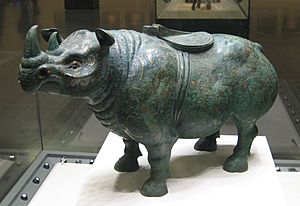
Found in 1963, this zun is shaped like a powerful standing rhinoceros. It has a raised head, pointed ears, and sharp tusks. Its eyes are made of bright black glass beads, giving it a graceful look. The lid on its back can open. The entire body is covered with cloud designs and spirals, all inlaid with shining gold and silver. This zun is a fantastic example of realistic art with beautiful, flowing decoration from the Western Han period.
|
See also
 In Spanish: Zun para niños
In Spanish: Zun para niños


